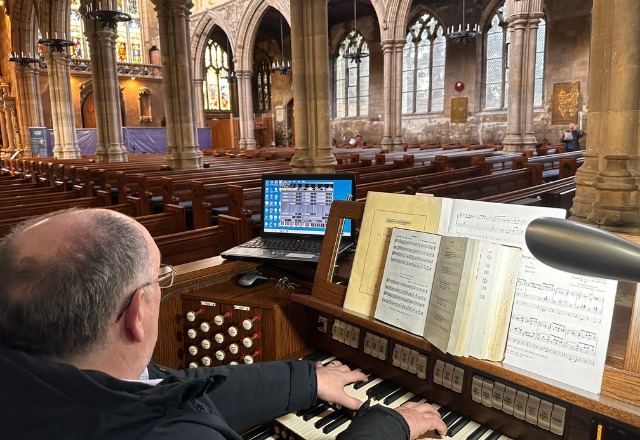One of the great joys of working in this business is the variety of people and locations we get to meet and visit. On that score it would be hard to beat St Mary’s Church in Beverley on both measures.
Many will associate Beverley with the better known Minster but if you ever find yourself in the area do visit both buildings which are very fine examples of the medieval building skills to be found all over the UK. Beverley Minster retains a fine pipe organ with some original Snetzler ranks while St Mary’s has now, perhaps sadly, lost its huge 4 manual pipe organ.
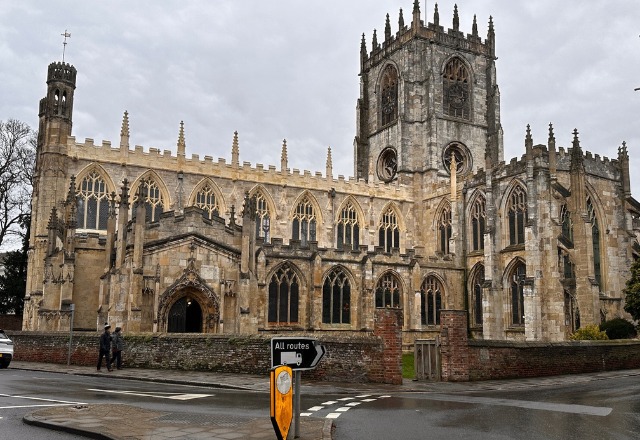
A building repair cost backlog
St Mary’s is a building of Cathedral proportions and maintenance costs with just parish church levels of income. With an urgent building repair cost backlog above £4 million which includes the north transept roof above the pipe organ, finding a million or more to restore what has been assessed as a large but somewhat undistinguished pipe organ is a job for well into the future. So pragmatically a much less expensive digital option was inevitably chosen to fill the gap.
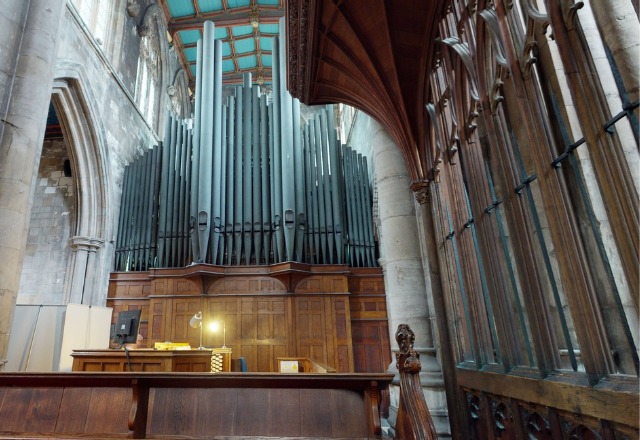
I first visited St Mary’s in September 2022 when we moved our large ‘Ex Canterbury Cathedral’ instrument there after an organ Battle at Selby Abbey some 30 miles distant. Selby Abbey suffers a little bit in the same way as St Mary’s. A fine Abbey building but in the shadow of the nearby York Minster as St Mary’s finds itself to Beverley Minster.
St Mary’s organ was limping on with significant electrical issues linking the remote console to the pipes. The organ would often just fall silent and if lucky, switching off and restarting would temporarily fix the problem. We use that same technique with electronic instruments too don’t we!
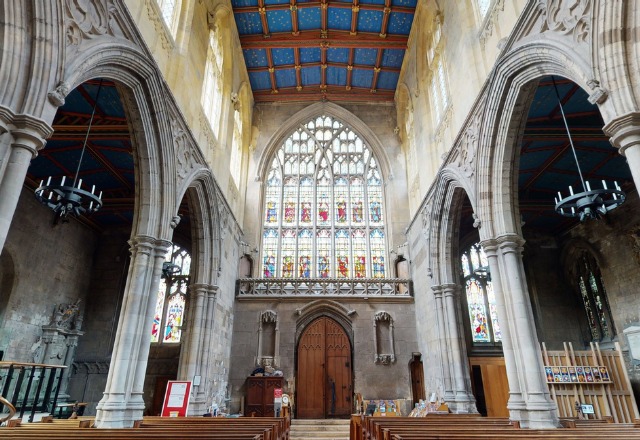
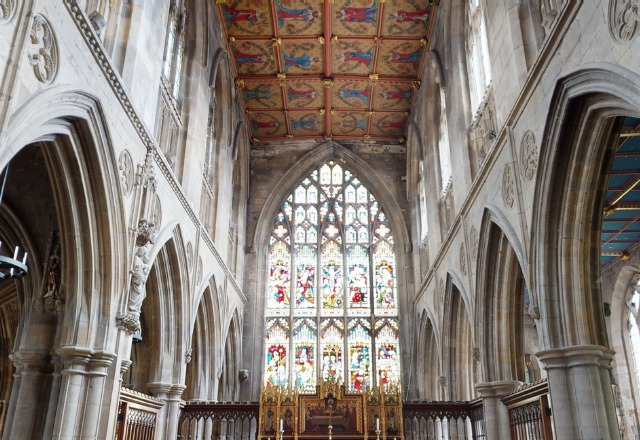
A temporary hire instrument is installed
With the plan to remove the pipe organ in due course so the transept roof above could be repaired, placing speakers in the pipe case was a nonstarter. Fortunately, a substantial Rood Screen offered an ideally placed central location that was inexpensive to access.
Sound from the transept had never penetrated the west end of the nave and I understand that the congregation seated at the rear of the church were not confident singers struggling to get any lead from the pipe organ. As it is so easy with digital technology to place part of the instrument in a different location the temporary hire instrument was set up with a west end division playing through speakers on the gallery just below the west window.
Within a day we had set up the instrument just in time for a wedding the following Saturday. This provided an opportunity for St Mary’s to evaluate our instrument as a solution to the increasingly unreliable pipe organ.
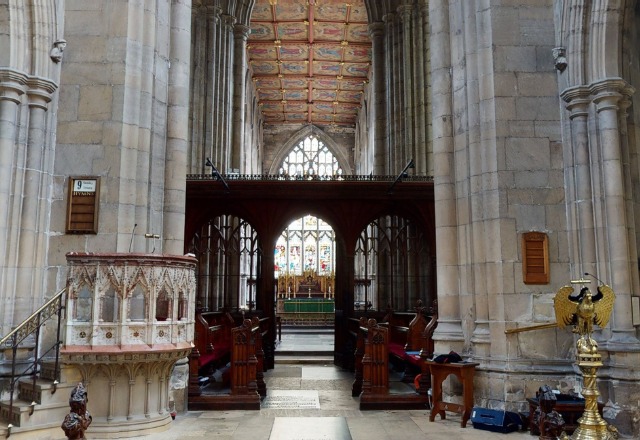
A longer term solution is required
Not long after the pipe organ failed completely, and the church were faced with the decision of a long term digital option or repair or replace the pipe organ. Harrison & Harrison prepared a detailed report which concluded that the cost of repair/rebuild was close to £1.5 million but that little of the pipework merited reuse. This was an analysis with which the two diocesan organ advisors concurred.
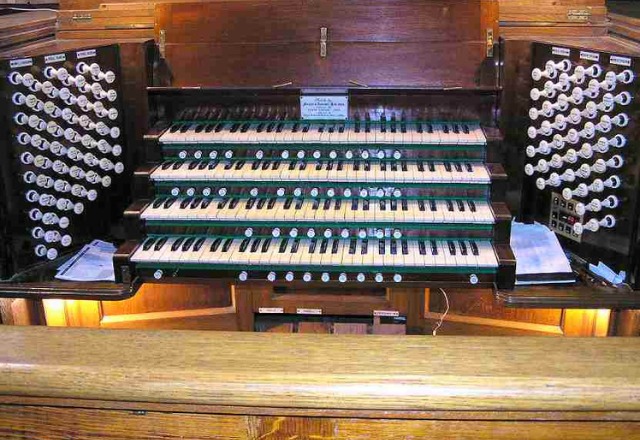
If a pipe organ were to be the preferred option it would need to be a new instrument or perhaps one in better condition salvaged from another building. Whichever plan nothing could proceed before about £2 million was spent on the roof above the transept. There was therefore no other option than a digital instrument filling the gap.
A faculty application was made toward the summer of 2023. This included relocating the organ console to the south side in the nave requiring the removal of some pews and matching the north side set up where pews had been removed in earlier years. At the same time an area of floor was taken up to allow for ducting to take speaker cables from the console to the screen so that the installation had near invisible cabling from its new location.
The organist now has direct line of site to the musical director and was slightly better placed to hear the instrument being further away from the main screen speakers.
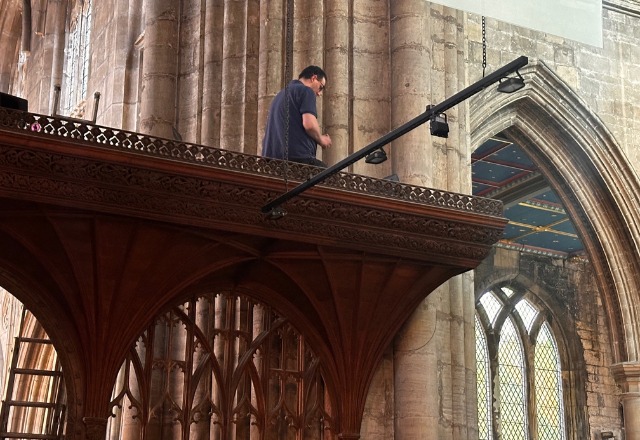
Deciding between a 3 or 4 manual organ
By the time the faculty was granted and the pew removal and ducting work planned the target for installation was Christmas 2023. I will explain later with just a little humour why we eventually installed the instrument in the first week of February 2024.
Shortly after our 3 manual Ex Canterbury instrument was installed it was needed for a pre booked hire in Winchester Cathedral. So we returned to Beverley in December 2023 and replaced it with a 4 manual instrument so the organists could evaluate if the reduction to 3 manuals had been a step too far.
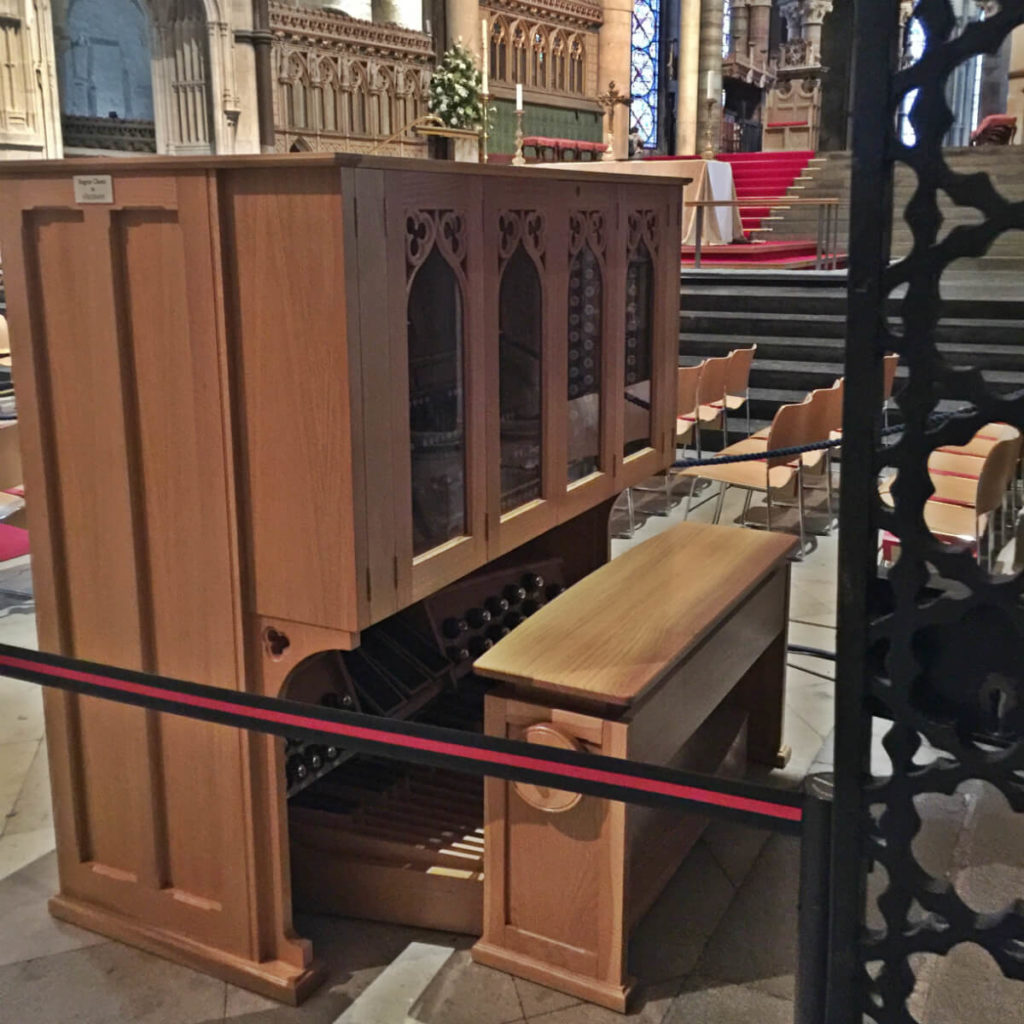
Eventually it was decided that 3 manuals were sufficient, and the instrument finally chosen was the Regent 361 moving drawstop with a small 7 stop floating Solo department. Almost a 4 manual instrument, with the advantage of a lower height console, over which the organist could see the choir director. It is also one of the first instruments to be built using the new Physis Plus technology, an evolution of the software generated sound generation introduced by Viscount a little over 10 years ago.
Installing the Regent 361 Physis+ organ
We arrived on a Monday lunchtime to recover our 4 manual loan instrument and install the Regent 361. Entry was only possible via the west door which was approached from the street down some gentle steps but lead to quite steep steps once inside the church. Gravity always helps the descent but still requires a strong and secure crew to mange it safely.
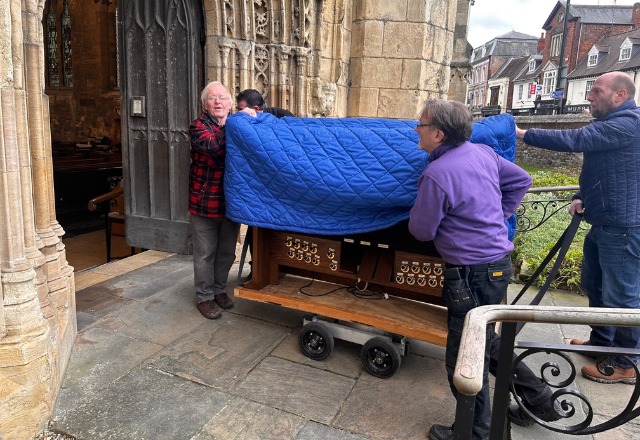
Taking the loan instrument back out however is a much greater challenge. Unfortunately, your author and cameraman on the day (me!) had to assist with the great push up the steps so no record of that herculean task was made. In all we had six shoulders to the wheel. It was also a task that had to be concluded on the Monday as the following day stonemasons arrived to remove the west end steps resulting in the closure of that entrance.
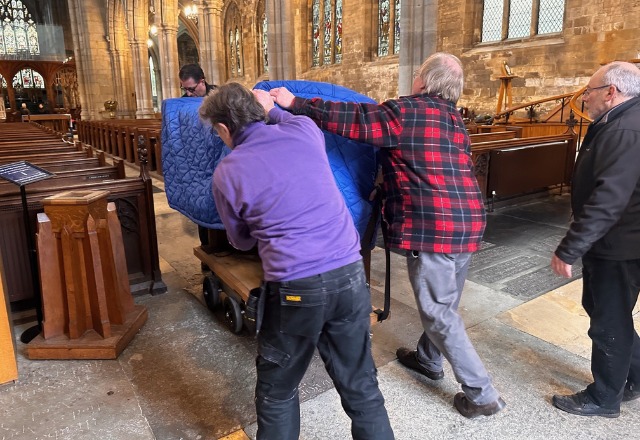
We were ready to start voicing the instrument by early afternoon on Tuesday finding ourselves in noise generation competition with angle grinders just inside the west door. Never ideal circumstances under which to work. Fortunately, the Wednesday was a haven of peace in comparison.
Bringing some music to try out the instrument
Its very difficult to remain disciplined on setting up a new instrument so I had brought some music with me to try the instrument out. My ability to improvise and ramble through the keys is quite limited. One of my party pieces is Scherzo for the White Rabbit by Nigel Ogden. A jolly little number doubtless seldom heard in church unless you happen to find I am playing the service! Here is very nice rendition of the piece on Youtube.
This led to an interesting coincidence as one of the stone embellishments to a doorway on the north side of the building is a white rabbit which is perhaps erroneously linked to a visit to St Mary’s by Lewis Carol. Known to be a frequent visitor to Yorkshire and Beverley the thought is that the carving inspired the character of the white rabbit in Alice in Wonderland.
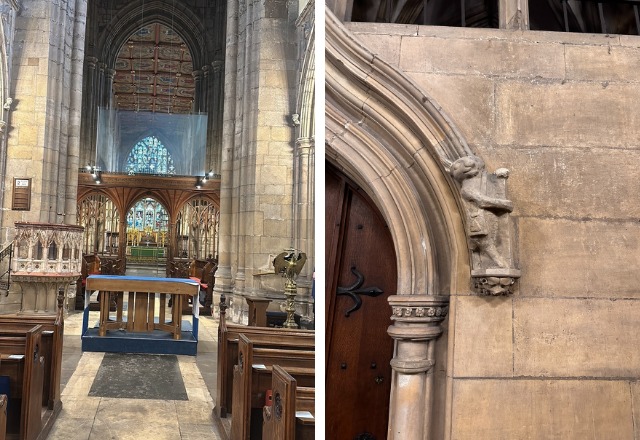
In fact it most likely represents a messenger hare documented in a well-known fable written by Odo of Cherinton – a Catholic preacher and writer in the 13 century. The hare features in a tale where a group of lazy townspeople realise at the last moment they have forgotten to pay their rent. They seek and catch a hare, and place their rent in a pouch tied to it, and instruct it to race to their landlord. Unfortunately, the hare ran in a different direction, and was never seen again.
I wonder what rabbit inspired Nigel to write his Scherzo. Happily, we only need to ask as he is still very much alive.
Installing extra speakers and voicing the organ
Anyway, back to the main task at hand. In making the permanent installation we increased the screen speakers from 8 to 12 in number. The sub bass were increased from 1 to 2.
A further 6 speakers are found at the west end where the entire instrument, minus all the reeds, was also set up as a switchable west end to be used when there was a fuller church. The volume level of these set very much to add a gentle support rather than setting a level uncomfortable for the congregation sat toward the rear of the church.
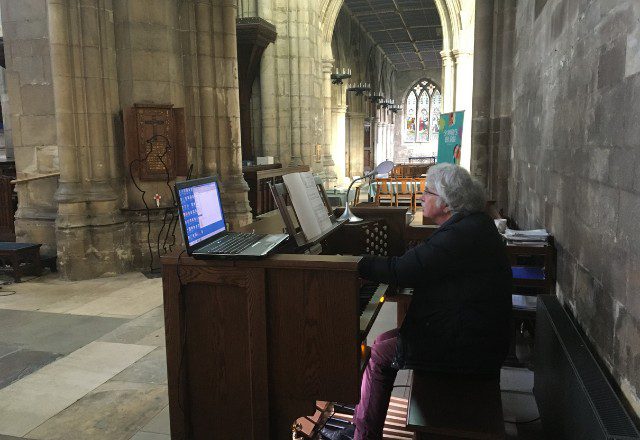
With colleague Richard Goodall we spent most of Wednesday with preliminary voicing adjustments. First balancing the choruses within each department and then setting departmental levels so as the swell box opened it finally cut through sitting just nicely on top of the main great chorus. Lastly we set the pedal individual stop levels to underpin the manual sound.
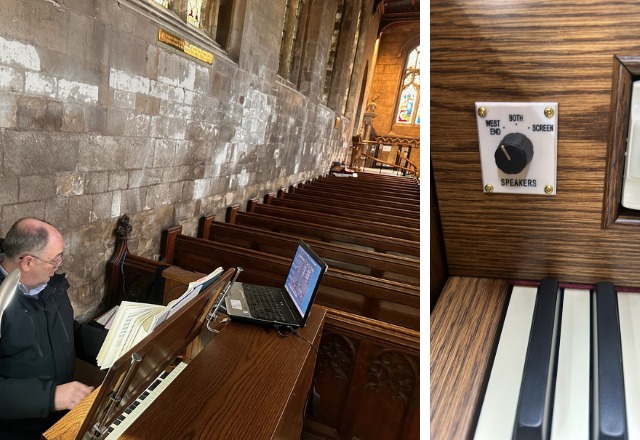
With two subs now only dealing with pedal stops due to further enhancement of the audio channel management provided in Physis Plus, a truly magnificent and large sound was created befitting of the space we were working in.
Finally we set about changing some voice models. Especially solo stops such as the swell oboe and choir trompette and clarinet to match the particular sound that organist Michael Ellerington had in mind.
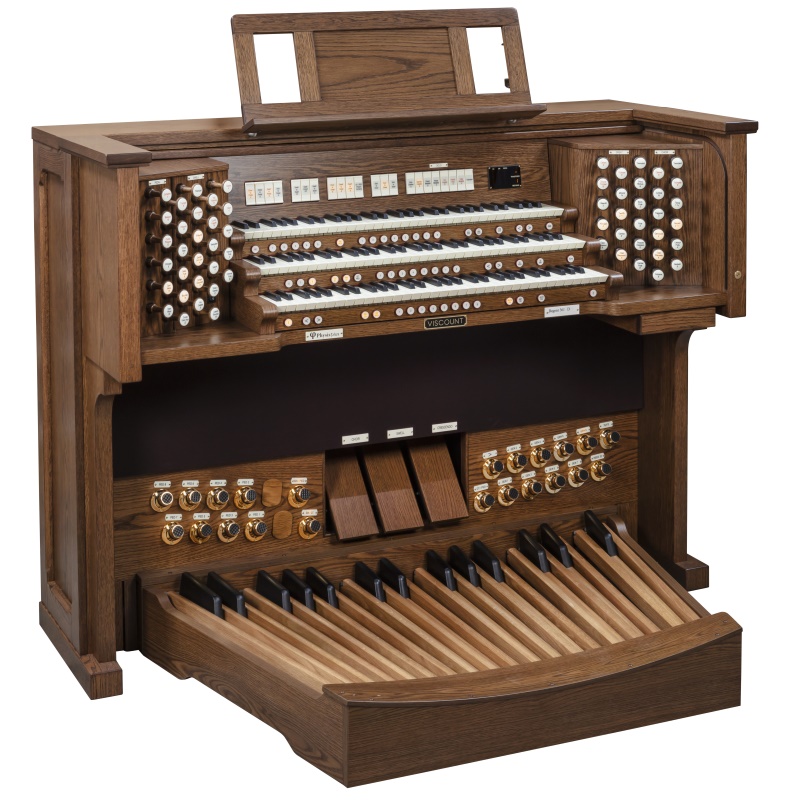
We will come back soon
We will now leave them well alone for a few months to experience use of the instrument in various different liturgical roles and with differing sizes of congregation before returning after Easter to fettle the instrument in finer detail.
And of course before leaving I could not resist playing a few rousing hymn tunes, mainly Welsh ones, with swell sub and super octaves in use enjoying the glorious sound of this new instrument rolling around the wonderful church.
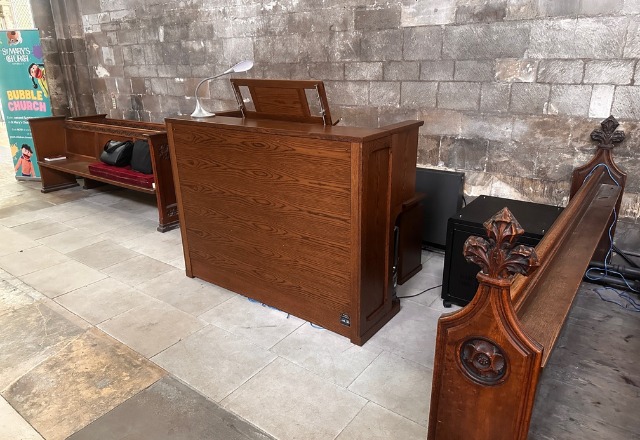
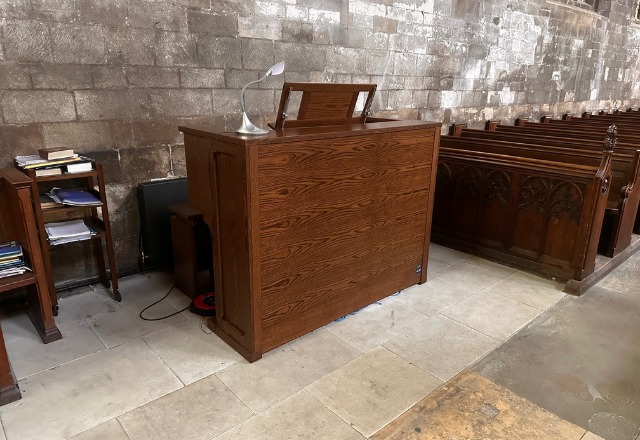
You too can enjoy the church by visiting our 3D model of the interior of the building.
Many thanks are due to organist Michael Ellerington and Vicar Reverend Becky Lumley for their tireless work in exploring with us the instrument options, the later faculty application task and finally arranging the work inside the church necessary for us to complete the installation.
Oh, I almost forgot. Why were we a few weeks late installing the instrument?
Well there was clearly some miscommunication on placing the order with the factory in Italy. The instrument arrived here in very good time, perhaps 2 months before it was needed and so it remained unopened in its large box. In late November we finally opened the box and to my horror and considerable disappointment an illuminated drawstop console presented itself, not the moving drawstops I had expected. As you can imagine this took more than a few moments to accept!
After a few phone calls, we had a plan to build a completely new instrument with moving drawstops which arrived in the UK in the 3rd week of January. A huge effort by colleagues in Italy, if I may once again refer to the rabbit, our Italian colleagues pulled a challenging rabbit out of the production hat, so the delay was just two weeks and not the many months I feared.
Mistakes happen but it’s how you recover from them that matters!
Client Testimonial
Michael Ellerington, the organist at St Marys Church, Beverley, shared this wonderful testimonial with us:
Back in 2014 it was clear that the large pipe organ at St Mary’s in Beverley had developed serious problems such that playing it was challenging to say the very least. It had been decided that neither a rebuild nor a replacement pipe instrument were financially viable which was later confirmed by a full survey by Harrison & Harrison and involvement of the Diocesan Organ advisors. With a huge contingent expense building fabric liability running into millions, including the roof above the pipe organ, our only realistic option was to purchase a digital instrument as a likely permanent replacement.
As team leader on the project, I contacted the major digital organs builders in the UK. The team at Viscount Organs UK, led by David Mason, made an excellent first impression resulting in a visit to their UK showroom in Bicester. David and his colleague Richard Goodall were very welcoming and spent plenty of time explaining Physis, the voice synthesising software developed by Viscount over many years. Time was available to play several instruments in their showroom and options regarding console design and different sound systems were discussed.
David and Richard visited St Mary’s the following week for a full site survey. As a result, Viscount was selected as the preferred builder.
By this time St Marys needed an organ – fast; the pipe organ had failed completely and there was a wedding less than a week later! Fortunately, Viscount were able to loan us a 2 manual instrument from their nearby outlet in Huddersfield. This, together with a limited sound system, was installed by Friday in time for the wedding the next day. This instrument proved very successful over the following 3 weeks.
With some concern as to the issues a reduction from 4 manuals to 3 might generate, in the following few months while faculty procedures were progressed, we explored two other Viscount instruments. Firstly, a custom built 3 manual installed after taking part in a Battle of the Organs concert in nearby Selby. After 3 months use of this we then upgraded to a standard 4 manual instrument, the Regent 469 which we retained until our new instrument was ready.
The trials of 3 and 4 manuals demonstrated the loss of the 4th manual was not at all critical allowing us to settle on a lower final cost. A second visit to Bicester allowed us to play the latest version of the physical modelling sound generation in a 3 manual instrument with a floating Solo division that gave us a larger range of stops without the expense of moving to a 4 manual instrument. We were able to change some of the stops from those in the standard instrument configuration and so the final decision was made.
The permanent installation would speak through 12 main speakers on the Rood screen, two floor standing Sub-Woofers and a further 6 speakers below the West window. As the west end division was to be mainly for congregational support, the west end does not include all stops. The reeds are all excluded from playing through these speakers. The make up of the west end was finally decided during the voicing as the choice of which speaker (or speakers) through which any stop plays is totally flexible. This gives huge scope for the voicer to perfect the fit of instrument to the building. The west end can also be added or not as the size of the congregation dictates. The huge Solo tuba stop was finally left on the rood screen.
Delivery and installation took place on 5th of Feb 2024. All the Viscount team worked tirelessly and by the end of the day the loan Regent 469 was out and the new Regent 361 was in place, connected and fully operational. David and Richard then spent a further day undertaking preliminary voicing.
We choose PhysisPlus over the original Physis system even though the voice library is much smaller than that of the original Physis. This is compensated by additional voicing parameters over Physis resulting in an excellent and authentic pipe organ sound.
St Mary’s is the first large PhysisPlus instrument in the UK. I and St Mary’s Musical Director are extremely pleased with the new organ. It sounded very good “straight out of the box” but since being revoiced recently by Viscount’s chief voicer, Francis Rumsey, it now sounds magnificent and has received many favourable comments from our choir and congregation as well as other organists, most recently Dr Carol Williams from the USA.
I cannot thank David Mason and his team enough for the time they have spent to provide St Mary’s with such a splendid instrument. It should serve as the foundation of the church’s music well into the future.
I would sincerely commend Viscount Organs UK to any organisation wanting/needing a digital organ where funding and/or space limits the installation of a traditional pipe instrument.
I have had a passion for church organs since the tender age of 12. I own and run Viscount Organs with a close attention to the detail that musicians appreciate; and a clear understanding of the benefits of digital technology and keeping to the traditional and emotional elements of organ playing.
